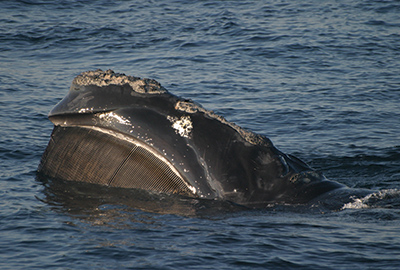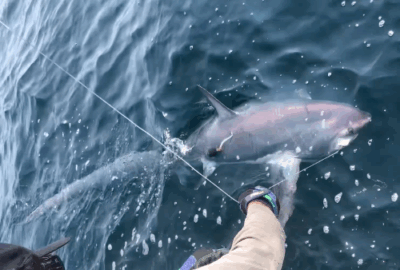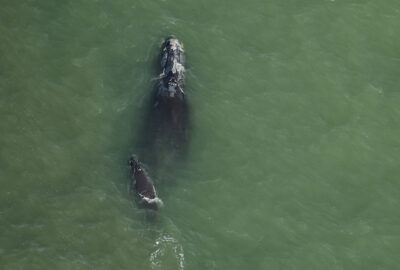Construction Update: As we enhance the look and feel of the Aquarium and make structural improvements to the penguin exhibit, some exhibits are temporarily closed, and the penguins are off exhibit until February 13. Learn more.
The Trust Family Foundation Shark and Ray Touch Tank will be closed from January 5 to January 7.
As the New England Aquarium’s dedicated research arm, the Anderson Cabot Center for Ocean Life uses science, policy, and market-based solutions to promote ocean-friendly practices and protect marine species and habitats. Learn more about our programs below.
Fisheries Science and Emerging Technologies (FSET) Program
To effectively manage and conserve the ocean’s resources, decision-makers need sound scientific data. We use cutting-edge technology to investigate critical fisheries issues, providing resource managers with the information they need to improve species, fisheries, and ecosystem management.
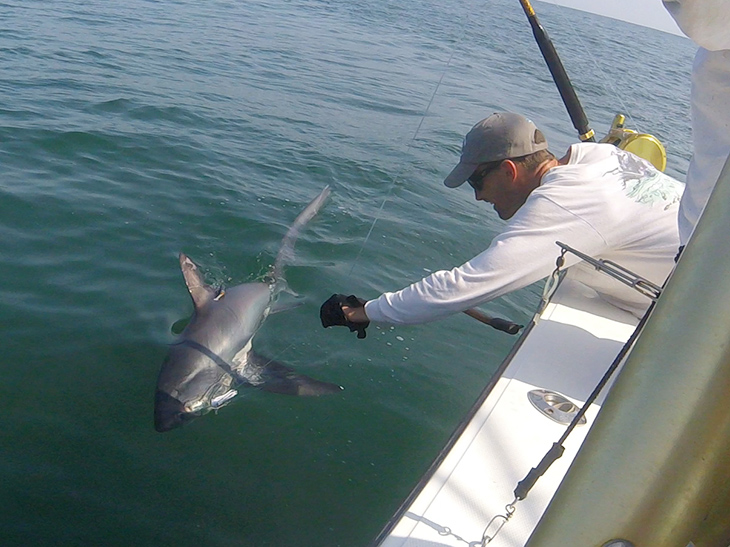
Featured Fisheries Science and Emerging Technologies Program Projects
Shark movement patterns determine their population structure and greatly influence the extent they are affected by human stressors such as habitat degradation or fishing pressure. Monitoring shark movements also provides key information on the location of ecologically important areas (such as feeding or nursery grounds) and insight into the influence of changing environmental conditions on shark distribution. We use acoustic and satellite telemetry to characterize short- and long-term shark movements and habitat use off Massachusetts and along the U.S. east coast. Data generated by our research are used to identify essential fish habitats and define population/stock structure for imperiled and commercial and recreationally important species. Current projects focus on juvenile sand tiger sharks in Boston Harbor, sandbar sharks in Nantucket Sound, and thorny skates and common thresher sharks in the Gulf of Maine and offshore waters.
Contacts: Ryan Knotek, Jeff Kneebone, Caroline Collatos, Nick Whitney
Millions of tons of sharks and other fishes are caught and released in commercial and recreational fisheries around the world every year. To properly manage and maintain the health of fished populations, we need to understand the rate at which released fish die and the factors that influence mortality. We partner directly with fishermen to observe and evaluate fish that are caught and discarded under authentic fishery conditions. Using advanced tagging technology, we track the movement and behavior of these fish in the days and months following their release to determine whether they survive. Our studies are designed to not only answer the question “How many fish die?” but also “Why do they die?” and “How can we improve their chances of survival?” Data generated by our studies directly inform and influence fishery management plans, fishing regulations, and stock assessment models. Our results also translate into “best-practice” guidelines that educate fishers on ways to minimize injury, stress, and mortality of the species that they frequently catch and release.
Contacts: Ryan Knotek
From Feeding to Breeding
The world’s largest sea turtle species, the leatherback, visits New England waters during their summer and early autumn foraging season. They later migrate to breeding areas in the tropics, including Florida, Central and South America, and many Caribbean islands. During their feeding and breeding seasons, leatherback turtles move into coastal habitats where they are prone to accidental capture in fishing gear and boat strikes. Our research seeks to understand the basic ecology of leatherbacks in their northern feeding grounds (New England) and during the breeding and nesting period in the tropics (Northern Caribbean), identify the magnitude and effects of human interaction in these key habitats, and inform science-based solutions to reduce or eliminate threats to sea turtles. We use various innovative tools and techniques to study these enigmatic, highly migratory turtles, including satellite and acoustic telemetry, camera tags, and oceanographic sampling.
Contacts: Kara Dodge
Renewable energy sources are essential to our clean energy future and must be developed in a responsible manner. We conduct rigorous, objective, and scientifically based research and monitoring to assess potential impacts of industry development on highly migratory species (tunas, billfishes, and sharks). Working with the renewable energy sector, we tag several species with acoustic transmitters and monitor their presence and movements within the wind energy areas before, during, and after offshore wind turbine construction. Grounded in science, best management practices reflect a commitment to our nation’s clean energy future, while also acknowledging the imperative to monitor and avoid, minimize, and mitigate the environmental impacts associated with offshore wind development.
Contacts: Jeff Kneebone
Shark mating behavior is rarely seen and nearly impossible to study directly. Most of what we know about mating behavior in sharks comes from rare, chance encounters by divers, or from this long-term study of nurse sharks in the Florida Keys. This project uses acoustic telemetry as well as cutting-edge camera and accelerometer tags to reveal the mating behavior of sharks using the same technology found in smartphones and Fitbits™. The goal is to use these and other tools to answer questions about where, when, and how sharks mate. How long do individual sharks continue to use this mating ground? What is the difference in mating frequency and energy expenditure between males and females, and what can this tell us about how these species are likely to respond to the loss of critical mating habitat?
Contacts: Nick Whitney
Kraus Marine Mammal Conservation Program
Since 1980, we have led research and conservation efforts on the critically endangered North Atlantic right whale, monitoring how human impacts have threatened this species. In collaboration with a community of researchers, we focus on using long-term data to evaluate the health of the species, monitor their habitats, and advocate for protective measures.
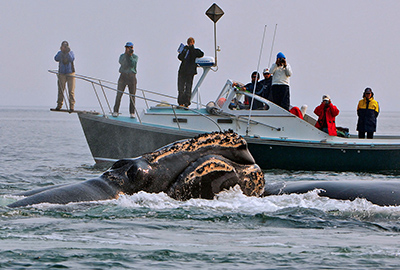
Featured Kraus Marine Mammal Conservation Program Projects
Knowing Every Individual of a Species
Our research team has been photo-identifying North Atlantic right whales since 1980 and curates the catalog of all known photographed sightings of this specie as part of the North Atlantic Right Whale Consortium. The core of what we know about North Atlantic right whales comes from our ability to distinguish one individual from another based on photographs of their natural markings and scars. This technique, referred to as photo-identification, allows us to track the life histories of individual whales throughout their lives: birth, deaths, migration, health, genetics, and anthropogenic injuries. The Catalog is the cornerstone of our work on this endangered species and is considered an invaluable data source by other researchers, federal and state agencies, industries and others who want to understand where right whales are found and how they are faring. The Catalog provides the data for annual population estimates and is also linked with studies on human impacts, visual health, genetics, behavior, hormones, microbiome carried out by us and our colleagues.
Contacts: Philip Hamilton, Amy Warren
Science at Sea
For over 40 years we have been conducting vessel and aerial surveys to monitor North Atlantic right whales throughout their range. Our research team has been instrumental in discovering and documenting their habitats. In 1980, we initiated vessel surveys in the Bay of Fundy after a small number of right whales were found there during an aerial survey for marine mammals and continued annually until 2020, when their primary summer habitat shifted elsewhere. In 1985, with the help of volunteer pilots, we discovered the calving ground in the southeast U.S. and helped develop a monitoring strategy that is now conducted by the states of Georgia and Florida. We have also conducted fieldwork on Roseway Basin (south of Nova Scotia), Cape Cod Bay (Massachusetts), Great South Channel, Cape Farewell Grounds (a historic whaling ground south of Iceland), and recently have expanded our efforts into the Gulf of St. Lawrence and southern New England, as right whales have shifted their distribution to those areas. Through our vessel survey work, we collect important photo-identification data, which contributes sighting, health, and scarring data to the North Atlantic Right Whale Catalog. In addition to photo identification, we also collect biological samples, such as skin, blubber, poop, and blow, which can provide a variety of genetic and hormonal information. We are in the process of creating and expanding a drone program which will enable our team to collect photogrammetry data and blow samples. Lastly, collaboration is a major piece of our fieldwork effort—we do not do this work alone! We have had many research collaborators up and down the east coasts of the U.S. and Canada over the years, including the Center’s Wildlife and Ocean Health program.
Contacts: Monica Zani, Kelsey Howe
Entanglements and Vessel Strikes are Taking a Toll
Right whales are exposed to human activities throughout their near coastal range in the U.S. and Canada which are affecting the continued survival of this critically endangered species. Our team carefully monitors all photographed sightings of individual right whales to assess the frequency, severity, and impacts on health of entanglements and vessel strikes, the main threats to this species. We carry out detailed scarring and visual health assessments annually and provide these data to managing agencies in the US and Canada and in reports posted to the North Atlantic Right Whale Consortium website. We also work with research teams in the U.S. and Canada to monitor injuries in near-real time and forward injuries of concern to a team at NOAA Fisheries that is evaluating these injuries in relation to an Unusual Mortality Event for this species. We have developed an Anthropogenic Events Database to capture all relevant information related to each documented interaction with human activities. In addition to monitoring anthropogenic events and impacts on health, we have been instrumental in developing and evaluating solutions and supporting government policies to implement science-based measures aimed at reducing these threats. These solutions include vessel speed restrictions, reduced breaking strength ropes, and on-demand fishing gear. Through our work, we will monitor whether implementation of these solutions that we are strongly advocating for are succeeding at reducing the frequency and severity of injuries and leading to improved health outcomes for right whales.
Contacts: Amy Knowlton, Heather Pettis
A Model for Advancing Science and Conservation of Marine Mammals
The New England Aquarium is a founding member of the North Atlantic Right Whale Consortium (NARWC), formed in 1986 by five organizations independently studying the endangered North Atlantic right whale along the east coasts of the United States and Canada. The NARWC’s goal to coordinate research efforts and protocols and share data among these founding organizations facilitated a broader understanding of North Atlantic right whale biology and conservation needs, including critical information on distribution, reproduction, mortality, and anthropogenic impacts. Expanding on this success, the NARWC developed an open membership model that now includes research and conservation organizations, industry stakeholders, and municipal, state, and federal agencies in both the United States and Canada. An annual meeting, a public website (narwc.org), and an annual “report card” are used to disseminate the latest information on right whale science and conservation progress and needs. The NARWC has served as the cornerstone for right whale research and conservation since its inception and its data sharing and collaborative framework is unparalleled in the marine mammal arena. Such an approach serves as a model for establishing other species related consortia, particularly for threatened and endangered populations. Additionally, the NARWC acts as host and curator for the WhaleMap platform, an interactive map designed to communicate the latest right whale observations and survey results to scientific, regulatory, and industrial sectors to inform more effective, dynamic planning of research and conservation activities.
Contacts: Heather Pettis, Kara Mahoney Robinson
The Gift of Conservation
Produced specifically for the Right Whale Sponsorship Program, the biannual newsletter Right Whale Research News provides in-depth stories about the latest field efforts, updates on sponsored whales, the status of the population, and efforts to protect them from human activities. By sponsoring a right whale, you are helping our efforts to monitor their population status, habitat use, calving rates, and migration patterns and our work to support effective management initiatives to save this critically endangered population. Meet the sponsorship whales.
Ocean Policy Program
Our policy team links science to policy to create tangible avenues to conservation action across species, spaces, and sectors—action that addresses the major challenges facing our ocean due to climate change. The Aquarium conducts the research needed to ensure reliable data is available for use in decision-making processes and industry practices.
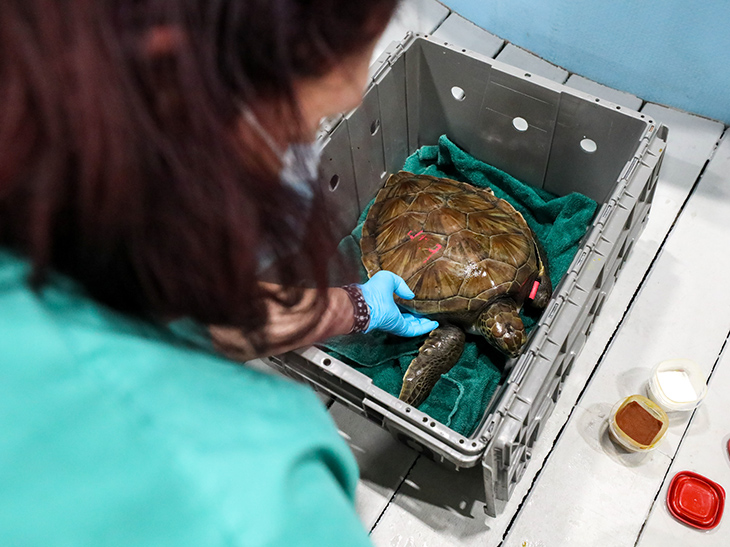
Featured Ocean Policy Program Projects
Co-develop science-policy solutions to address the human caused impacts to marine species in a changing climate, including impacts to marine mammals, elasmobranchs and sea turtles.
Marine Mammals: The leading causes of mortality confronting the critically endangered North Atlantic right whale are entanglement in fishing gear and vessel strikes. When not lethal, entanglements make it harder for right whales to grow and get pregnant because of energy loss associated with entanglement. Guided by the science showing the problems caused by entanglements, the Aquarium supports a generational transformation to remove vertical fishing rope from the water column and implement ropeless or “on demand” gear as fast as practicable: ropeless technology is a path forward to prevent unnecessary deaths and injuries while keeping fishermen on the water. The species recovery has also been limited by the effects of vessel strikes. The current level of vessel strikes to right whales exceeds sustainable levels of impact. We conduct scientific research to inform whether, where, and for how long certain vessel sizes should be subject to speed restrictions so that the smallest spatial and temporal footprint needed to protect right whales from extinction can be embraced by the broader vessel-based community. Our work and its associated data are relied upon to support regulatory protection of North Atlantic right whales, and we have served as expert witnesses for congressional testimony on the matter.
Sea Turtles: Sea turtles are economically and culturally important and serve important roles in the environment, maintaining healthy habitats, and cycling nutrients between the land and the ocean. Thousands of sea turtles are killed or injured globally each year by human activities, and the majority of sea turtle species are now endangered. The many threats to sea turtles include interactions with fishing gear, alteration and loss of habitat, extreme weather and climate change, boat strike, pollution, oil spills, and environmental toxins, such as the toxin that causes red tide. We study turtles across the breadth of their life cycle, from nesting females, to juveniles, to adults, and the Aquarium’s turtle hospital has one of the highest caseloads worldwide, treating hundreds of patients each year. Our work and its associated data have been successfully used to support legislative protection of sea turtles, where we have also served as expert witnesses for congressional testimony on the matter.
Elasmobranchs: The Aquarium has a strong focus in applying cutting-edge technology to answer important fisheries questions, including a robust elasmobranch research program. Thorny skate abundance in the Gulf of Maine is currently at historic lows despite a possession ban on the species since 2003. At present, it is not known if the continued decline is due to ongoing incidental fishing mortality, environmental factors that are affecting the population through reduced productivity and/or distribution shifts, or a combination of these factors. To answer these questions, we worked with local commercial fishermen to deploy pop-up satellite archival tags and investigate thorny skate movement patterns and habitat use in the Gulf of Maine, and to estimate the discard mortality rate of thorny skates that are caught as bycatch in the northeast commercial trawl fishery. Data collected by these studies are currently being used to better define thorny skate population structure in the North Atlantic, and have improved our understanding of the role water temperature and fishing pressure play in the species’ recovery in the Gulf of Maine.
Developing strategies for responsible ocean use
The Aquarium’s scientific research is directly contributing to the 30×30 initiative, including in the U.S. as part of the federal America the Beautiful initiative. Protected waters are one of many ways we work to tackle the biodiversity and climate crises facing our collective communities, while supporting responsible ocean use. For example, the Northeast Canyons and Seamounts Marine National Monument was established due in part to our extensive research. Our research has also demonstrated that this Monument has some of the highest marine mammal diversity on the U.S. East Coast. We conduct aerial surveys of the Monument that reveal an area teaming with wildlife (e.g., sperm whales, whale sharks, Chilean devil rays), and we brief legislators on the ecological and cultural importance of this and other protected areas. We inform the development of strong, holistic management plans for marine national monuments and national marine sanctuaries to effectively steward the areas long after designation. As we prepare for climate change and sea level rise at our home on Boston’s Central Wharf, we support a more comprehensive approach to waterfront planning that incorporates climate “resiliency, accessibility, and inclusivity.” Through partnership, we seek to protect our coastlines and build more resilient communities.
A fight against the climate crisis
A major transformation of the ocean-based blue economy is underway with the development of offshore wind and aquaculture, among other viable blue economy innovations. A responsible future blue economy prioritizes science, equity, and conservation and is where clean energy and food security needs are met alongside the protection of species and marine habitats. In an already highly used and warming ocean, we supports the need for rigorous, scientifically based review of industry development, practices, and ocean policies—from renewable offshore energy to fishing—to avoid, minimize, or mitigate harm to marine species and their habitats. Leading with science, we work with state and federal policymakers and industry to promote the responsible use of the ocean, such as through our responsible blue economy state legislative agenda. For more than a decade, the Aquarium has led surveys of marine animal habitats in waters slated for wind energy development. New England Aquarium’s scientific research informs state and federal decision-making and contributes to the data collection needed to understand and adaptively manage impacts to marine species.
Spatial Ecology, Mapping, Assessment, and Photogrammetry (EcoMAP)
Researchers with our EcoMAP team assess risks to marine species from human activities and climate change. We conduct our assessments in collaboration with stakeholders to develop solutions to the most pressing marine conservation challenges.
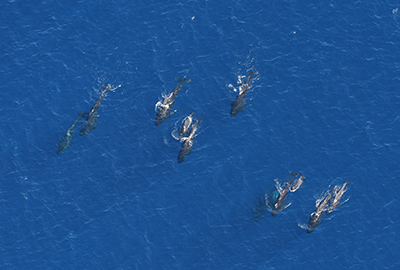
Featured Spatial Ecology, Mapping, Assessment, and Photogrammetry Program (EcoMAP) Projects
The New England Aquarium has been conducting aerial surveys of New England waters since 2011, including an area sited for wind energy development off Massachusetts and Rhode Island. This research is conducted in collaboration with the Massachusetts Clean Energy Center, Bureau of Ocean Energy Management, and individual wind energy development companies. These surveys collect data on the distribution and abundance of marine mammals and turtles. These data are critically important for mitigating effects of wind energy construction and operation on protected species. Analyses conducted using these data include estimating species abundance, developing models to understand species habitat, and assessing trends in the abundance and demographic patterns of right whales.
Contacts: Orla O’Brien, Jessica Redfern
Located approximately 150 miles off the coast of Cape Cod, the Northeast Canyons and Seamounts Marine National Monument is the first and only marine national monument off the continental United States. The monument was designated in 2016, with the help of Aquarium scientists. Our researchers have been conducting aerial surveys of the Monument since 2017 to collect valuable species distribution data. Although this remote area is difficult to survey, each flight yields amazing offshore sightings, including sperm whales, blue whales, beaked whales, large pods of dolphins, and whale sharks. These surveys have demonstrated an incredible diversity and abundance of marine mammals in the monument and lend support to the case for its continued protection.
Contacts: Orla O’Brien, Jessica Redfern
Our oceans are becoming increasingly industrialized as shipping, fishing, recreational use, and renewable energy development increase. It is important to identify areas where human use of the ocean overlaps with sensitive marine species. Identifying these areas allows us to develop solutions that reduce risks to these species. The goals of our research are to map the overlap between species distributions and human use, identify risks associated with this overlap, and assess the potential for reducing these risks. Our research includes assessing displacement of whales during wind energy construction, quantifying the economic trade-offs between mitigating impacts on protected species and wind energy development, and analyzing the exposure of whales to vessels and the risk of vessels striking whales. We also create tools to support decision-making by stakeholders and managers to resolve spatial use conflicts using the best available science. To support the resolution of spatial use conflicts we identify areas of the greatest overlap with whales and vessel traffic, identify vessel types that are frequently near whales, and explore changes in the risk of a vessel striking a whale associated with moving vessel traffic and/or reducing vessel speeds. Finally, we make recommendations for optimizing data collection protocols to provide the greatest conservation value for protected species.
Contacts: Laura Ganley, Jessica Redfern, Dan Pendleton
Features that support marine mammal foraging have been suggested as important components to include in Marine Protected Areas, but research is needed to understand the relationship between these features and diversity. For example, the Northeast Canyons and Seamounts Marine National Monument represents an area known to support marine mammal foraging and was designated to protect an area of high marine mammal diversity. However, no comparisons have been made between marine mammal diversity in the monument and other areas. This research increases our understanding of what makes the monument unique by identifying how species diversity in the monument is different from diversity in the Northwest Atlantic Ocean. This research also helps identify sites in U.S. East Coast waters that could be considered candidates for meeting the goal of protecting 30 percent of areas of particular importance to biodiversity (i.e., 30×30).
Contacts: Jessica Redfern, Dan Pendleton
Climate change affects important aspects of marine wildlife, including abundance, distribution, phenology, and habitat use. Our research focuses on measuring the effects of climate change on marine mammals, understanding the overlap of marine mammal habitat with human activities, and improving our understanding of possible future changes. We collaborate broadly with oceanographers and field biologists, and our research uses data from satellites, climate models, and marine mammal surveys. Throughout our work, we seek to understand how essential physical and lower-trophic level biological variables propagate through the food web to higher trophic levels (baleen whales in particular), and how future climate change will affect marine mammals.
Contacts: Dan Pendleton, Laura Ganley
Wildlife and Ocean Health Program
Our mission is to understand, monitor, and reduce the consequences of human activities on the health of marine species and ecosystems. We take an integrated approach to assessing wildlife health, often pioneering innovative tools, to deliver evidence-based science on how animals are affected by a rapidly changing ocean.
